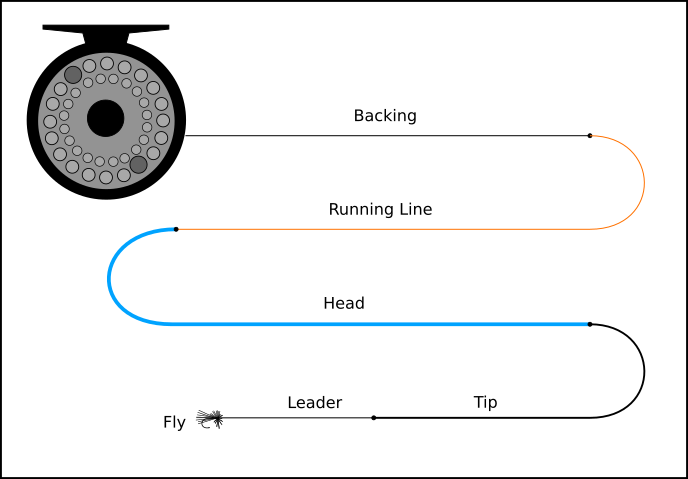Traditional fly line
The typical fly line setup consists of 4 sections:
- Backing (Custom length)
- Fly line (Typ. ~100′)
- Leader (Typ. 2′-12′)
- Tippet (optional ~1′-3′)

Backing
Fly line backing serves two main purposes:
- Provide extra line to prevent getting spooled when fighting big game fish that take long runs.
- Fills out a spool so the fly line wraps on top of the backing around a larger radius. Provides the advantage of reeling in more line per turn of the handle. It also prevents the line from being wrapped around in small tight circles (bad for fly line memory).
Typical fly lines are typically between 90′ to 110′ long. If you are fishing for large strong fish, particularly in currents, they could easily draw our 100′ of line. To provide you with more line to fight the fish, backing line is used.
Fly line is expensive, spooling on 200′ of fly line would be wasteful as it’s rare to find someone able to cast out their entire fly line. A typical fly fisherman only casts about 50′. So to create a fly line that’s greater than 100′ a cheap backing line is used to extend the line to prevent from getting spooled. The thick diameter of fly line also prevents the spooling of a lot of line, particularly on small arbor reels.
The most common backing material is Dacron, a braided line, as it is quite cheap. Also available is gel-spun backing, which has higher breaking strength for the same diameter as dacron, but is more expensive. Another alternative some people use heaving monofilament.
That said, backing isn’t the most important part of the fly line setup. Most people never hook a fish that takes them into their backing. However, when one does, it becomes an invaluable insurance policy.
Fly line
Flies, are very light. It is practically impossible to cast a fly further than a couple of feet using conventional equipment, such as a spinning rod. This is because of the fly’s light weight and high drag. In order to cast out flies long distances, fly fishers a line that is heavily weighted which can be casted by itself. The weighted line, which is what is cast out, then carries with it the light fly with it. This the opposite of spin fishing where the line is very light and a heavy lure is cast out, carrying the line with it.
Modern fly lines are typically made of a braided line core (nylon or dacron) which is encased in PVC. Fly lines tend to have very little stretch due to their braided line core. Some fly lines, such as clear intermediate sinking lines, use a fluorocarbon core. The PVC coating usually has additives that make the line more buoyant, or to make it sink as a desired rate.
Fly lines are either floating or sinking. Most commonly, floating lines are used to deliver floating flies, and sinking lines to deliver flies below the surface. However, this is not a strict rule as floating lines are used to deliver weighted flies that are designed to sink below the surface and sinking lines used to deliver flies that float a few feet above the bottom (with the line laying on the bottom). Sinking lines also come in a variety of sink rates.
To add to the complexity, fly lines come in constant diameters, or with diameters that grow and shrink along its length. Normally, the purpose of varying the diameter of a fly is to concentrate weight towards the tip to make casting further or casting bigger flies easier. Other forms of tapered lines, also place heavier weight near the tip, however, the diameter tapers down gradually towards the tip to help with unrolling the line over and delivering a better fly presentation.

- Weight Forward
- Double Taper
- Level Taper
- Shooting Taper https://www.bigskyfishing.com/fly-fishing-articles/fly-lines-guide3.php
Leader
The leader is a section of line that connects the fly line to the fly. It is usually clear and thin in diameter. The leader can be as short as 1′ to 2′ for sinking lines and as long as 6′ to 12′ for floating lines. The main materials used to construct a leader is monofilament and fluorocarbon.
Tapered leaders of often used as the taper helps to unroll or turn the fly over. Smooth tapered leaders are readily available on the market. Tippets are recommended to preserve the leader from frequent leader clipping of fly changes.
Tapered leaders can also be fabricated at home using multiple sections of 1′ to 3′ long constant diameter monofilament or fluorocarbon. Each section of line has a smaller diameter (or test strength). The sections are tied together using small profile line to line knots. Best knots for making tapered leaders are the blood knot or triple surgeon’s knot.
Tippet
Tippets are usually 1-3′ long and made of monofilament or fluorocarbon. The purpose of the tippet is to improve the longevity of the tapered leader, so that you don’t keep clipping off a segment of leader every time you change flies.
Spey line
